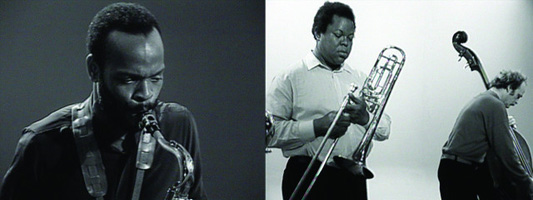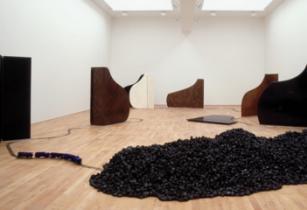Exhibition Reviews
| Home | | Museum Guide | | International | | Theater |
The Whitney Museum Plays the Blues
By Adèle Bossard
The blues has become one of America's basic music language. Since the publication of W. C. Handy's “St Louis Blues” sheet music in 1914, known to be the song that popularized the blues, it has swept through the globe and is now ubiquitous in jazz, rhythm & blues and rock'n roll. With its new exhibition, “Blues for Smoke,” on view until April 28, 2013, the Whitney Museum of American Art explores a large array of contemporary art, from the 1950s to the present, through the lens of blues as an artistic sensibility and cultural idiom.
The blues has roots in the American “Deep South” at the turn of the twentieth century, where it grew out of the hard lives of black workers and sharecroppers. “The blues were conceived in aching hearts,” said W.C. Handy. Those shouts and chants were meant to express sadness, disillusionment and all the political and social troubles experienced by the African-American society of this time. It emanates from people for whom slavery was a recent history and basic civil rights were still far in the future. “Blues for Smoke” offers to discover this unique aspect of American culture through the prism of contemporary art. Seen from a contemporary point of view, the blues embraces such fundamental issues as identity, personal and social catastrophe, sexuality, improvisation or extravaganza. This leads us to think of a “blues aesthetic” that goes beyond the only medium of music. The exhibition also features a large variety of media, including photography, video, painting, drawing, sculpture and multimedia installation. More than ninety works, by more than fifty artists, are on display.
To get to the exhibition, just follow the music of David Hammons' “Chasing the Blue Train” that greets the visitors at the entrance of the Whitney's third floor. While several recordings of jazz classics play simultaneously, a toy train is set up with a track, through a tunnel covered with coal and goes in and out of piano lids as obstacles. Coal may represent the Industrial Revolution and its new opportunity of wealth and growth. However, the coal mines were also sources of strife or oppression and the train suggests the ceaseless mobility of Black laborer, the blues of endless daily underground travels. The blues as a state of mind appears through another artwork tinted blue: K. Newkirk's installation in which a shopping-cart deposits a circular mound of blue glitter. With a dirty towel, an empty glass bottle and a rope hanging on its metal structure, the cart is the carrier of a whole life and refers to a social reality that might produce the blues. Three painting from the large “No Room” series by Glenn Ligon are part of the exhibition, a series of dozens of paintings all displaying Richard Pryor's joke:
Pryor's poignant observation expresses the trauma of everyday life and Ligon's paintings give it a new voice. Ligon shows that blues can exude from other media than music; from painting or even from the speech of a famous stand-up comedian.
In “Souvenir IV,” Kerry James Marshall pays tribute to cultural figures and civil rights leaders, recalling the blues as a traditional mourning song. Rodney McMillian, for his part, refers to the ambivalent religious roots of the blues with a whole room he converted into a church exclusively for this show. The church is surrounded in red vinyl plastic but it reminds us of the “Deep South” architecture: it suggests the Dockery farms, cotton plantations where Blues musicians used to reside, which are now considered the sacred homes of blues mythology. For those who are not totally fulfilled, different multimedia spaces offer opportunities to explore the blues through videos and listening posts. Attractions include a full episode of HBO's drama “The Wire,” a video-clip of the Harlem native singer Azealia Banks and a video-show of Richard Pryor. Finally, in the lobby gallery, an entire room is devoted to Stan Douglas' “Hors Champs” that explores the visual representation of a musical performance.
Adèle Bossard is a free lance writer from Saumur, France. |



